LiFePO4 Cell Voltage Chart - A Comprehensive Guide (3,2 V 12 V 24 V 36 V 48 V 72 V)
The lithium iron phosphate battery (LiFePO4) (abbreviated as LFP) uses lithium iron phosphate as the positive electrode material, a graphite carbon electrode, and metal as the negative electrode. Due to its low cost, high energy density, long lifespan, safety, and stability, it is widely used in electric vehicles, golf carts, forklifts, camper vans, floor machines, scissor lifts, boom lifts, marine transportation, airport ground support, home energy storage, as well as industrial and commercial energy storage.
Use a LiFePO4 voltmeter to monitor the performance, condition, and charging/discharging parameters of the LiFePO4 battery. This will ensure optimal usage and significantly extend the battery’s lifespan.
LiFePO4 Battery Voltage Basics
To better understand the voltage of a LiFePO4 battery, it is important to know several basic definitions:
Nominal voltage – 3.25 V is the rated voltage of the battery. The standard voltage is used to monitor battery charging and discharging.
Storage voltage – 3.2 V–3.4 V If the battery will not be used for an extended period, it should be stored at this ideal voltage. The storage voltage reduces battery capacity loss, thus ensuring its proper operation.
Fully charged – Charged to 3.65 V, which is the maximum voltage. If the battery is charged above this level, it may cause irreversible damage.
Discharge voltage – 2.5 V is the minimum discharge voltage. It is not recommended to discharge the battery below this voltage. If the battery is discharged beyond the limit, it may be damaged.
Deep discharge – In this case, the voltage is below the recommended level. After deep discharge, the LiFePO4 battery may fail completely.
LiFePO4: 12 V 24 V 36 V 48 V 72 V
| SOC | 1 cell (3.2 V) | 12 volts | 24 volts | 36 volts | 48 volts | 72 volts |
| 100% charging | 3.65 V | 14.6 V | 29.2 V | 43.8 V | 58.4 V | 87.6 V |
| 100% odpoczynku | 3,4 V | 13,6 V | 27,2 V | 40,8 V | 54,4 V | 81,6 V |
| 90% | 3,35 V | 13,4 V | 26,8 V | 40,2 V | 53,6 V | 80,2 V |
| 80% | 3,32 V | 13,28 V | 26,56 V | 39,84 V | 53,12 V | 79,68 V |
| 70% | 3,3 V | 13,2 V | 26,4 V | 39,6 V | 52,8 V | 79,2 V |
| 60% | 3,27 V | 13,08 V | 26,16 V | 39,24 V | 52,32 V | 78,48 V |
| 50% | 3,26 V | 13,04 V | 26,08 V | 39,12 V | 52,16 V | 78,24 V |
| 40% | 3,25 V | 13 V | 26 V | 39 V | 52 V | 78 V |
| 30% | 3,22 V | 12,88 V | 25,76 V | 38,64 V | 51,52 V | 77,28 V |
| 20% | 3,2 V | 12,8 V | 25,6 V | 38,4 V | 51,2 V | 76,8 V |
| 10% | 3 V | 12 V | 24 V | 36 V | 48 V | 72 V |
| 0 | 2,5 V | 10 V | 20 V | 30 V | 40 V | 60 V |
Cell Voltage Chart LiFePO4 3.2 V
The voltage of a single LiFePO4 cell is typically 3.2 volts. When fully charged, the voltage ranges from 3.55 to 3.65 V. When completely discharged, the voltage drops to 2.5 V. The chart below illustrates the real-time voltage drop as the battery capacity decreases.
• Nominal voltage: 3.2 V
• Charging voltage: 3.55 - 3.65 V (recommended: 3.55V)
• Float charging voltage: 3.3 - 3.4V (recommended: 3.4 - 3.5V)
• Discharge cutoff voltage: 2.5 V (recommended: 3.0 - 3.1V)
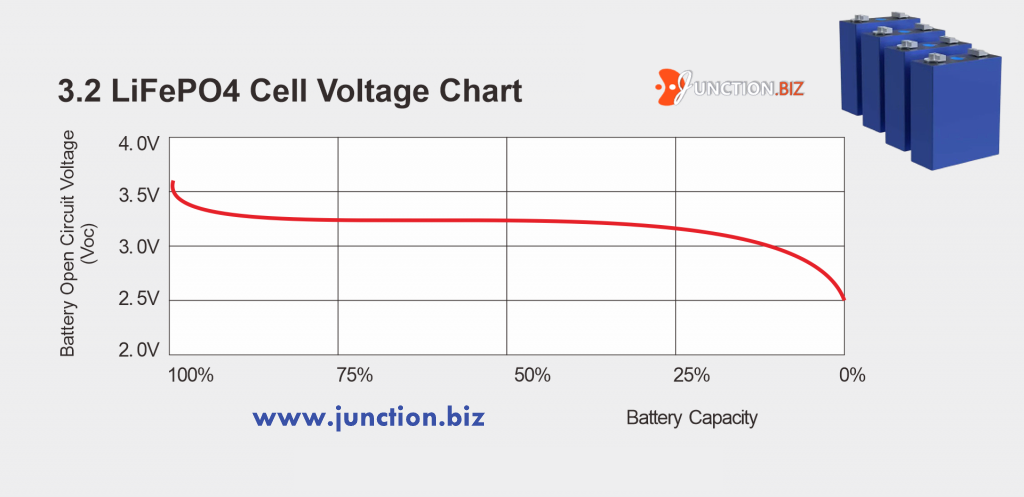
Battery Voltage Chart LiFePO4 12V
12 V is the ideal voltage for electric bikes, trolling motors, marine batteries, aerial work platforms, and home solar energy. The chart below illustrates the real-time voltage drop as the battery capacity decreases.
• Nominal voltage: 12 - 12.8 V
• Charging voltage: 14.2 - 14.6 V (recommended: 14.2V)
• Float charging voltage: 13.6 V (recommended: 13.6V)
• Discharge cutoff voltage: 10 V (recommended: 12.0 - 12.8V)
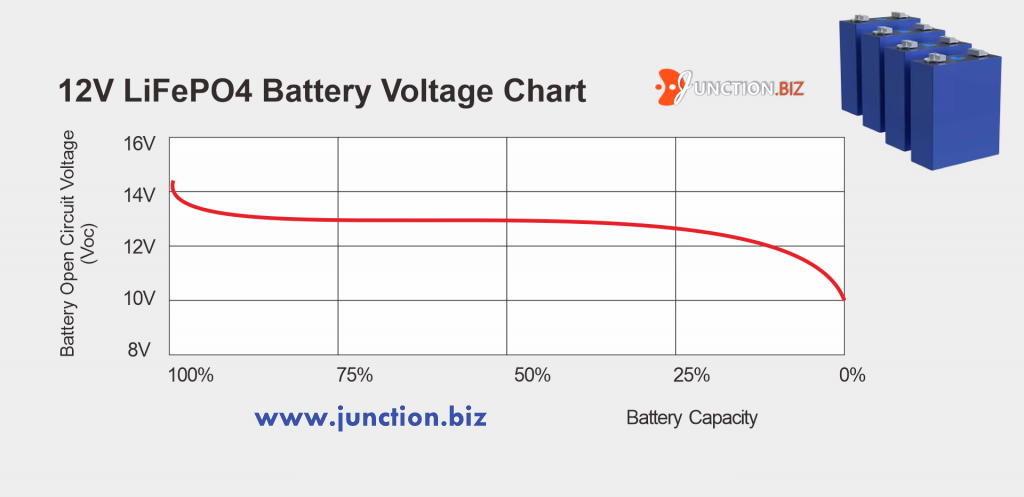
Battery Voltage Chart LiFePO4 24V
24 V LiFePO4 batteries are perfect for use with boat trolling motors as well as scissor lifts and boom lifts. Sweepers, floor cleaning machines, and RVs also benefit from this energy source.
You can buy a 24V LiFePO4 battery or purchase two identical 12V batteries and connect them in series. The chart below illustrates the real-time voltage drop as the battery capacity decreases.
• Nominal voltage: 25.6 V
• Charging voltage: 28.4 - 29.2 V (recommended: 28.4V)
• Float charging voltage: 27.2 V (recommended: 27.2V)
• Discharge cutoff voltage: 20 V (recommended: 24 - 25.6V)
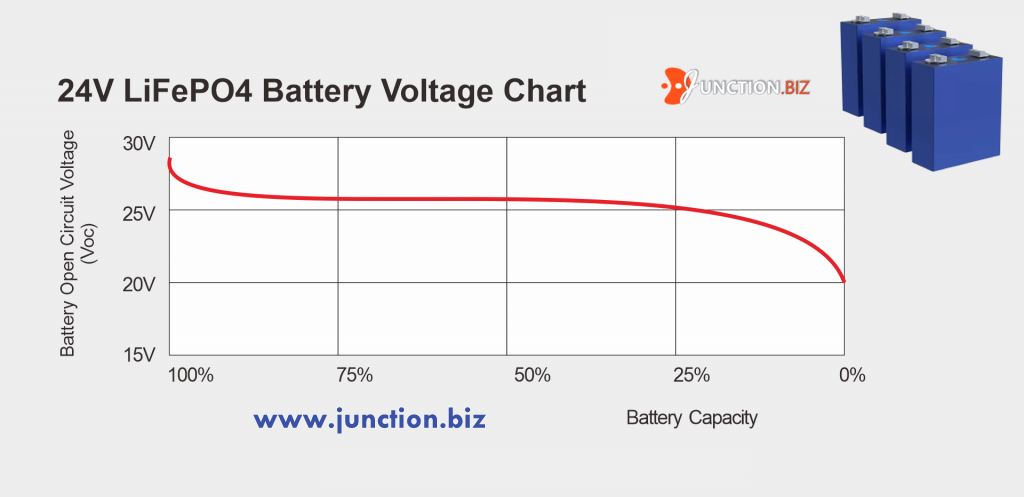
Battery Voltage Chart LiFePO4 36V
36V batteries are rarely used and are mainly found in golf carts, electric cars, toys, UTVs, and ATVs. The chart below illustrates the real-time voltage drop as the battery capacity decreases.
• Nominal voltage: 36 - 38.4 V
• Charging voltage: 42.6 - 43.8 V (recommended: 42.6V)
• Float charging voltage: 40.8 V (recommended: 40.8V)
• Discharge cutoff voltage: 30 V (recommended: 36 - 38.4V)
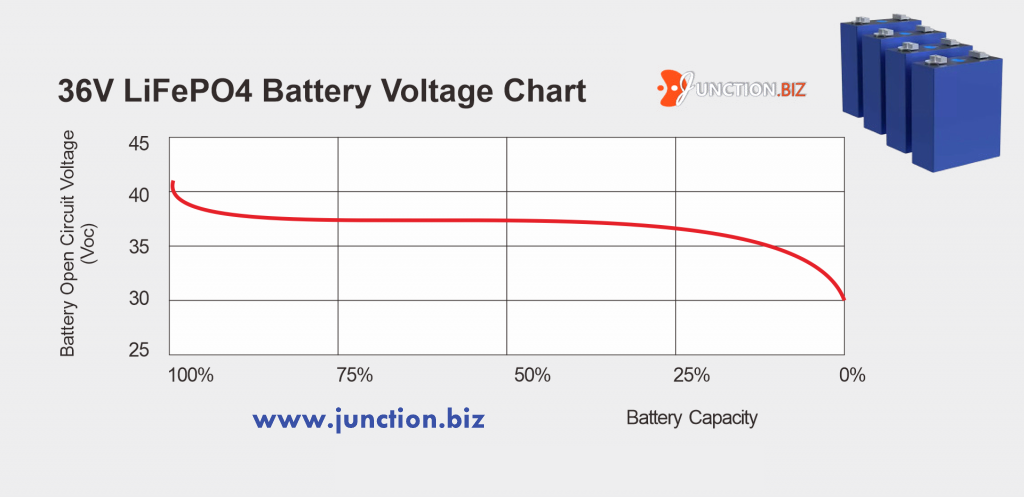
Battery Voltage Chart LiFePO4 48V
48V is the best choice for home solar energy, 5 kWh - 20 kWh power supply systems, electric golf carts, aerial work platforms, all kinds of household appliances, and server rooms. The chart below illustrates the real-time voltage drop as the battery capacity decreases.
• Nominal voltage: 48 - 51.2 V
• Charging voltage: 56.8 - 58.4 V (recommended: 56.8V)
• Float charging voltage: 54.2 V (recommended: 54.4V)
• Discharge cutoff voltage: 40 V (recommended: 48 - 51.2V)
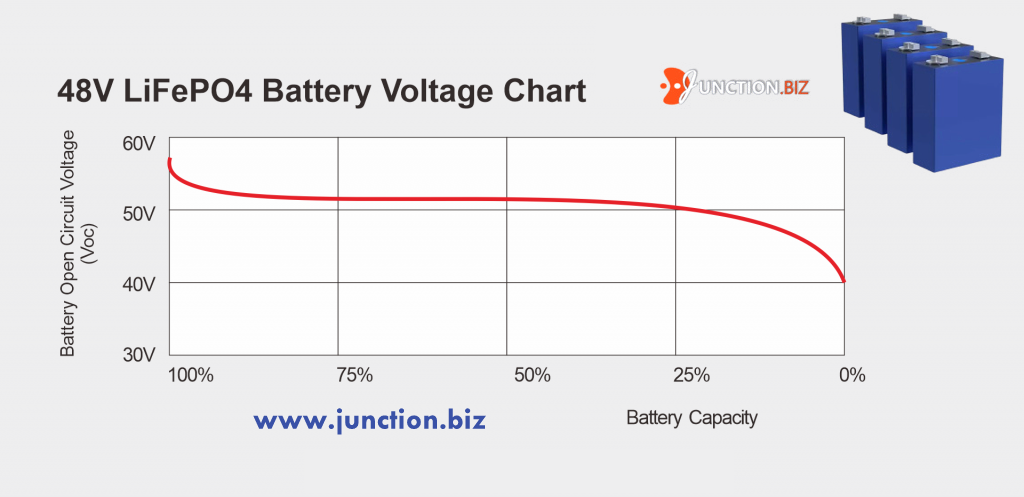
Battery Voltage Chart LiFePO4 72V
72V batteries are designed for 72V golf carts, electric cars, touring vehicles, and outboard motors. The chart below illustrates the real-time voltage drop as the battery capacity decreases.
• Nominal voltage: 72 - 76.8 V
• Charging voltage: 83.6 - 87.6 V (recommended: 83.6V)
• Float charging voltage: 81.6 V (recommended: 81.8V)
• Discharge cutoff voltage: 60 V (recommended: 72 - 76.8V)
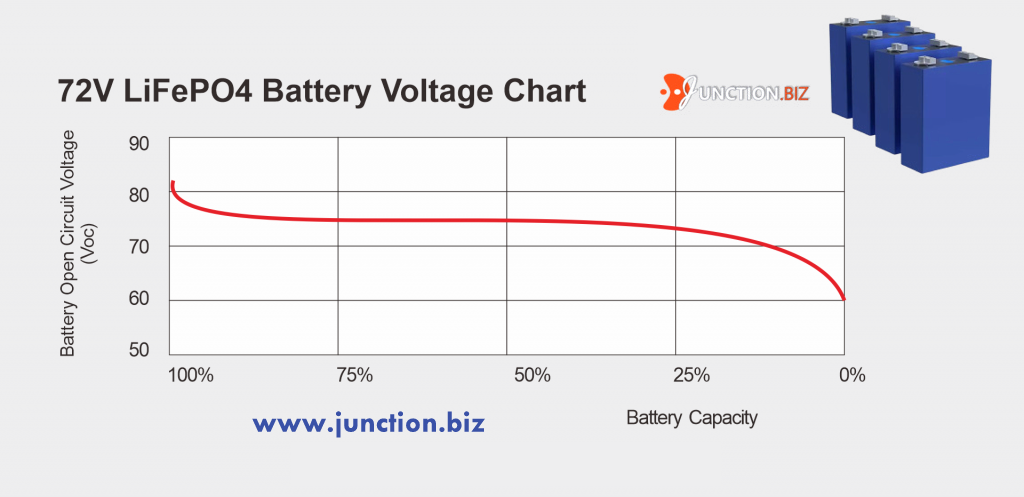
LiFePO4 Battery Charging Parameters
The performance, health, and durability of the battery are ensured by following the recommended charging parameters. During charging, every user is obligated to adhere to these parameters. Make sure the battery is neither overcharged nor undercharged to ensure effective energy storage and extended battery life. The LiFePO4 battery charging parameter table is shown below.
Constant voltage, float charging, and equalizing voltage of LiFePO4 battery
LiFePO4 batteries have three voltage stages: bulk, float, and equalization. In the bulk stage, constant current is supplied to the battery to quickly charge it to a specific voltage. Float voltage is applied to the battery in the float stage. This increases the efficiency and longevity of the battery. The equalization stage balances the cells by ensuring even charging.
| Specification | 3.2 V | 12 V | 24 V | 36 V | 48 V | 72 V |
| Charging Voltage | 3.5-3.65 V | 14.2-14.6 V | 28.4–29.2 V | 42.6-43.8 V | 56.8–58.4 V | 83.6-87.6 V |
| Float Voltage | 3.2 V | 13.6 V | 27.2 V | 40.8 V | 54.2 V | 81.6 V |
| Maximum Voltage | 3.65 V | 14.6 V | 29.2 V | 43.8 V | 58.4 V | 87.6 V |
| Minimum Voltage | 2.5 V | 10 V | 20 V | 30 V | 40 V | 60 V |
| Nominal Voltage | 3.2 V | 12/12.8 V | 24/25.6 V | 36/38.4 V | 48 V/51.2 V | 72/76.8 V |
What is the relationship between the State of Charge (SOC) and LiFePO4 battery voltage?
The State of Charge (SOC) of a battery indicates the level of its charge relative to its capacity. Regarding SOC, 0% is fully depleted or discharged, and 100% is fully charged.
DOD is another measurement related to SOC, calculated as 100 – SOC (100% when fully charged, 0% when depleted). While SOC generally indicates the current condition of the battery during use, DOD generally refers to the battery's lifespan after multiple charge and discharge cycles.
When the battery reaches a low SOC (close to 0%), the Battery Management System (BMS) intervenes to prevent over-discharge. Similarly, when the battery approaches a high SOC (close to 100%), charging is slowed or stopped to protect the battery.
Example: The discharge capacity of a 100Ah battery is 30Ah. As a result, the SOC is 30%. After charging the battery to 100Ah and discharging to 70Ah, 30Ah remains.
Charging Curve
Voltage: It is commonly believed that the higher the nominal voltage of a battery, the more fully it is charged. A 3.2 V LiFePO4 battery is fully charged when it reaches 3.65 V.
Coulomb meter: This device measures the current flowing into and out of the battery and quantitatively determines the rate of charging and discharging of the battery in ampere-seconds (As).
Specific gravity: A hydrometer is required to measure SOC. Liquid buoyancy can be used to measure its density.
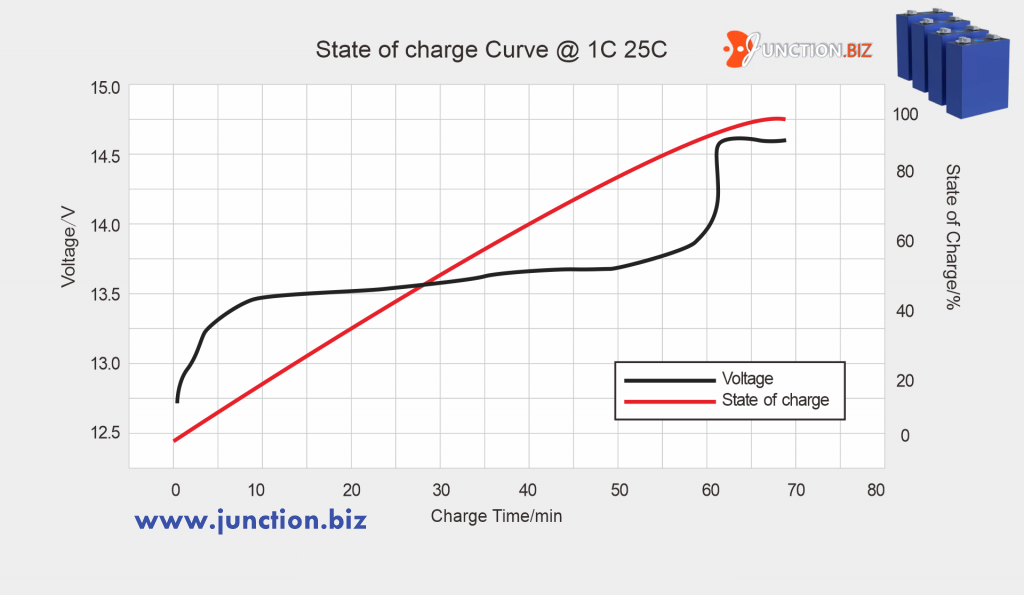
LiFePO4 Battery Discharge Curve
Discharging refers to the process of extracting electrical energy from the battery to power an electronic device. The battery discharge curve usually shows the relationship between voltage and discharge time. The figure below shows the discharge curve of a 12 V LiFePO4 battery at different discharge rates.
Depth of discharge is one of the most important factors in extending battery life. In short, the more frequently a LiFePO4 battery is charged and discharged, the shorter its lifespan.

How to Check the Capacity of a LiFePO4 Battery
The best way to ensure long-term performance of your LiFePO4 battery is regular checking and monitoring. LiFePO4 batteries can be accurately measured using the following methods.
Multimeter -
Multimeters provide accurate voltage readings and battery capacity measurements.
External Battery Monitor -
This reliable battery testing method can determine the battery's capacity. In addition to assessing the condition of the battery, its capacity, voltage, and discharge energy, the battery monitor also predicts its lifespan.
Charging via Inverter or Solar Controller -
The capacity of a LiFePO4 battery is checked by solar charge controllers. This method can be used in solar energy systems.
Monitoring App -
Some LiFePO4 batteries can be monitored and controlled remotely. Smartphone apps allow for monitoring of performance, voltage, and other features.
The formula for calculating battery capacity is as follows: Capacity = Discharge Current (A) x Discharge Time (hours).
Structure and Working Principle of LiFePO4 Battery
On the left side of the LiFePO4 is the positive electrode, connected to the battery's positive electrode via aluminum foil. In the middle is a polymer separator that allows lithium ions (Li+) to pass through while blocking electrons (e-). Copper connects the negative terminal of the battery to the graphite (carbon) negative electrode on the right side.
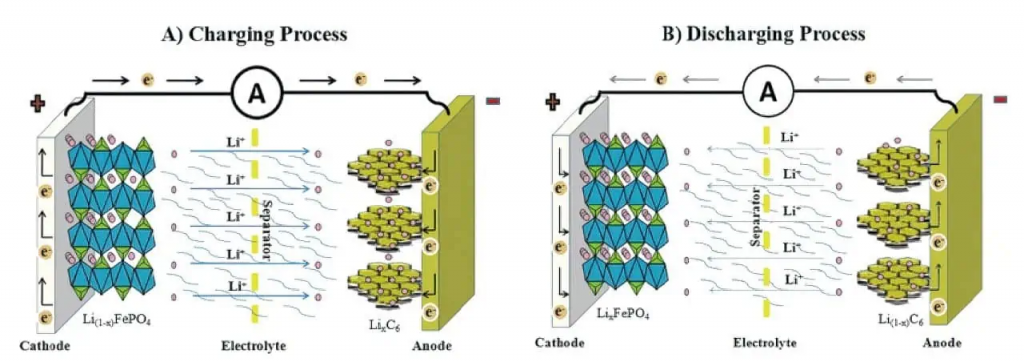
Charging Process:
During oxidation, LiFePO4 releases lithium ions (Li+) and electrons (e-). The negative electrode receives lithium ions (Li+) passing through the electrolyte and separator. The negative electrode stores lithium ions (Li+) in carbon (graphite).
Discharging Process:
Through the electrolyte and separator, lithium ions (Li+) move from the negative electrode to the positive electrode. A reduction reaction occurs between the lithium ions (Li+) and LiFePO4 at the positive electrode, releasing electrons (e-). The powered device is powered by the released electrons (e-) flowing through the external circuit. The lithium ions (Li+) and electrons (e-) in the battery continue cycling during charging and discharging.
Factors Affecting the Lifespan of LiFePO4 Batteries
Temperature plays a crucial role in the durability of LiFePO4 cells. Maintaining proper operating conditions is essential to achieving maximum efficiency and long lifespan, which translates into greater benefits for users and the environment. For maximum longevity of LiFePO4 cells, operation in moderate temperatures, typically between 10°C and 30°C, is recommended. This is the range where the cells are most stable, allowing chemical and mechanical degradation to be minimized.
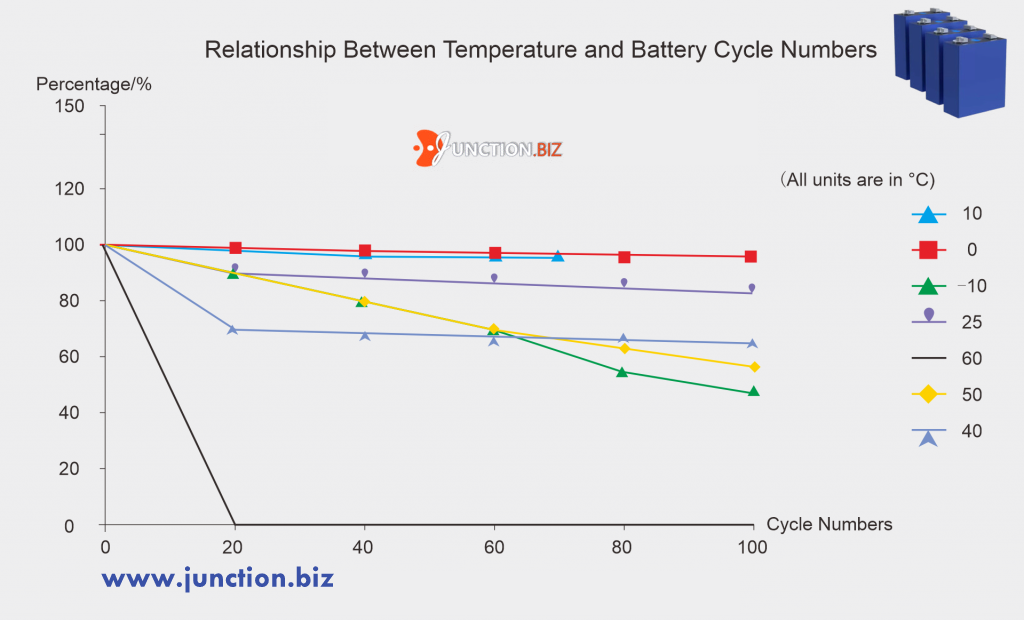
Voltage – It is commonly believed that the higher the nominal voltage of a battery, the more fully it is charged. A 3.2 V LiFePO4 battery is fully charged when it reaches 3.65 V. Coulomb meter: This device measures the current flowing into and out of the battery and quantitatively determines the rate of charging and discharging of the battery in ampere-seconds (As).
Depth of Charge and Discharge Cycles is one of the most important factors affecting the lifespan of LiFePO4 cells. Operating within optimal voltage ranges and avoiding extreme levels allows maximizing cell longevity and utilizing their full potential. The Battery Management System (BMS) can further support the user in maintaining proper cell operating parameters, increasing the safety and efficiency of the system. Regular use of shallow discharge cycles (e.g., discharging the cells only to 70–80% of their nominal capacity) has a positive effect on durability. This allows the cells to achieve a greater number of charge-discharge cycles, often exceeding 5000–8000 cycles under such conditions. This means a longer cell lifespan and more stable operation over time.
| Voltage | Capacity | Charge Cycles | Lifespan (above 80% of original capacity) |
| 14.4 V | 100% | 3200 cycles | 9 years |
| 13.6 V | 100% | 3200 cycles | 9 years |
| 13.4 V | 99% | 3200 cycles | 9 years |
| 13.3 V | 90% | 4500 cycles | 12.5 years |
| 13.2 V | 70% | 8000 cycles | 20 years |
| 13.1 V | 40% | 8000 cycles | 20 years |
| 13.0 V | 30% | 8000 cycles | 20 years |
| 12.9 V | 20% | 8000 cycles | 20 years |
| 12.8 V | 17% | 6000 cycles | 16.5 years |
| 12.5 V | 14% | 4500 cycles | 12.5 years |
| 12.0 V | 9% | 4500 cycles | 12.5 years |
| 10.0 V | 0% | 3200 cycles | 9 years |
Charging and Discharging – It is important not to overcharge or over-discharge the battery. Connecting and disconnecting the charger at the right moment is essential. Overcharging and excessive discharging affect the battery's lifespan.
Depth of Discharge – To scientifically extend the lifespan of lithium iron phosphate batteries, deep discharges should be avoided whenever possible.
Operating Environment – To avoid negatively affecting the performance of the LiFePO4 battery, do not use the battery in high or low temperature environments. A heated LiFePO4 battery is the best choice if the battery is to be used in lower temperatures. Over-discharging any LiFePO4 battery can lead to irreversible damage and reduced lifespan. To optimize durability, it is recommended to keep the depth of discharge below 80%.
How to Extend the Lifespan of LiFePO4 Batteries? – The above LiFePO4 voltage charts provide a comprehensive overview of the voltage characteristics of LiFePO4 batteries, along with their capacity, charging cycles, and expected lifespan. To optimize the performance and lifespan of LiFePO4 batteries, users can refer to the above tables and responsibly consider them in the process of using and configuring devices that work with batteries. By using these voltage charts, users can make informed decisions regarding voltage levels, charging cycles, and expected battery lifespan, ensuring optimal performance and durability of LiFePO4 batteries.
March 23, 2025 - M.M. Junction.biz
The article uses materials from LiFePO4 battery manufacturers, available at: https://www.lithium-battery-factory.com
Article translated, edited, and supplemented by Junction.biz. All rights reserved. Copying, reproducing, and sharing content published on our pages, in whole or in part, without the written consent of Junction.biz is prohibited.





